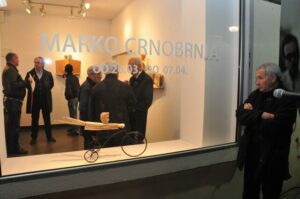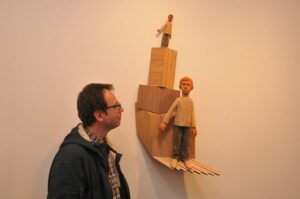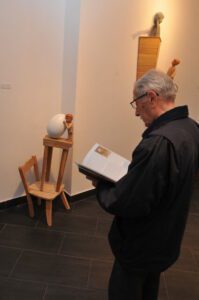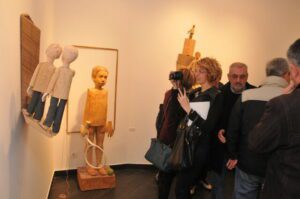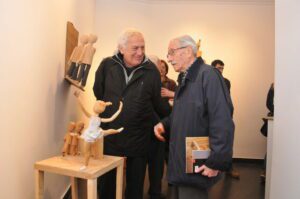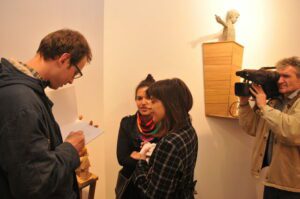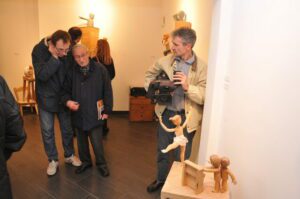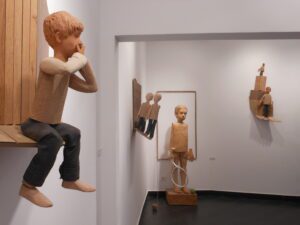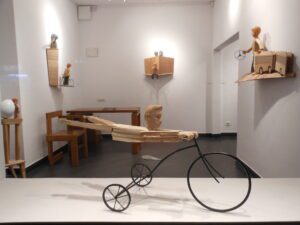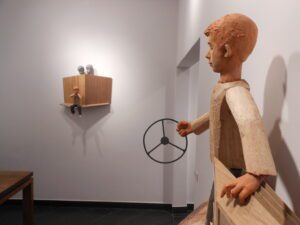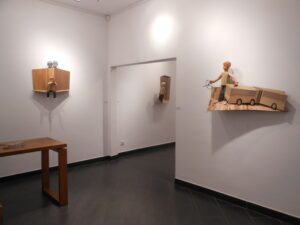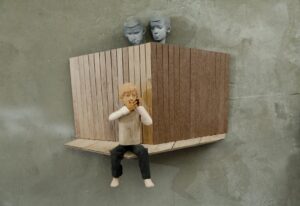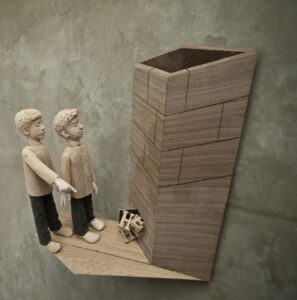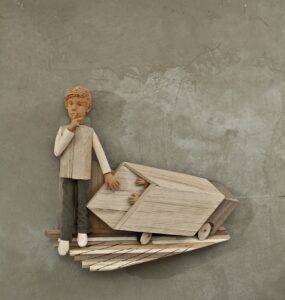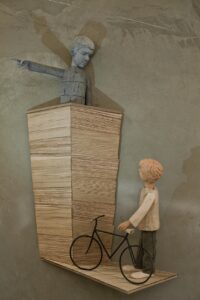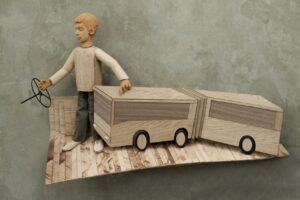Stevan Vuković
From the Construction to the Reconstruction of Childhood
Every artist creates or conveys a speci c worldview through the works of art, which one can fully comprehended only when joining the language game they invite us to. The worldview offered to us by Marko Crnobrnja is children centered. It dis- closes their striving for new experiences in their immediate surroundings, as well as the wondrous and provocative nature of the everyday sights they face, which remain unnoticed by the grown-ups, burdened by their inner lives and externally imposed obligations. That view results from the overlapping of the artworld and the lifeworld of the artist, and is created through the attempt to see things both as a parent and an artist, through active collaboration with children and by learning from them, while observing and analyzing, at the same time, both their behavior and conduct, and his own self-re ection and diving into the childhood images in his unconscious. At the beginning, in the phase of acquiring parental experience and getting into the role of a father, the author has introduced sculptural objects into his relationship with his children, to use them as mediators of emotive and in- tellectual contents, as well as sculpturally realized scenes, to activate their imagi- nation in projecting the implications of those scenes, as well as their intellect in making value judgments related to the implications of those scenes. Later on, Crnobrnja’s children became his accomplices in the very process of conceptual- izing the visual features of some elements of those scenes, that were copied from their drawings, while up to now they got to be the most uncompromising critics of his work, leaving the author to look for further inspiration for this kind of work in the evocation of his own childhood. That is why the focus of this project, that goes on for full ten years, playfully combining the communicative, educative and formal aesthetic functions of sculptures, as well as with the way they get positioned and experienced in a domestic surroundings, in galleries and in the framework of pub- lic and private collections, has shifted from constructing a fragmentary image of childhood to reconstructing fragments of images from authors memories of his childhood.
Crnobrnja develops a specific metaphorical language, which uses figures of children as avatars in the world from which all details with no specific role in the presented narrative are removed, in which all potential indicators of historic time, geographic space and the social positions of these characters are minimized, and in which the scenographic elements induce an additional feel of the isolated nature of the scene and the metaphysical emptiness of the surrounding. Situations in which we encounter these figures are just indicated, not fully presented, and are accompanied by semi-disclosed street enigmas and states of affair just before some event, whose character can be just guessed by the viewer, which all has to serve as a trigger for the imagination of the audience. Imagination easily fills all those deliberately left holes in the symbolic structure, adds contextual elements and emotional color to the scenes, and puts them into a diachronic line with the scenes that one could imagine as having preceded them and those that could follow. At first glance, the photographic reproductions of several of these works seem as frozen frames of some missing or lost animations on the traces of Czech surrealism, and that impression is so strong that one who sees those photos before seeing the sculptural scenes of which the photos were taken, could experience them as a display of props used for constructing the narrative in a lm or a photo work. On the other hand, the lack of contextual features as integral elements of these sculptural scenes enables their easy integration into some private home, office or any other non-gallery setting, in which they look as if they were made solely for decorative purposes, but with a slightly shifted scale of aesthetic values, which are not usual for decorative sculpture. When summarizing all this and putting it into a relation to the gallery type of displays of this oeuvre, and the way it strikes us in the setting of the studio in which it was made, one gets an impression of facing a type of work which also constantly functions as a projective test for every prospective viewer, enabling him or her to interpret it in his or her own manner.
The children presented in these sculptural scenes are not shown as being in some romantically conceived ‘state of nature’, in which only their spontaneous open- ness, naivety and frankness would be stressed as the strong counterpoint to the alienation of the adults. They are not shown as fully consumed by playing, taken away by the pleasure principle and devoid of any responsibility, which would then be solely a thing of their parents. The children in Crnobrnja’s work are in the con- stant process of investigating and researching the surrounding reality, in a manner which is frequently transgressive, facing them with potential dangers and bring- ing them into situations in which their wrong choice could bring about undesired consequences. The educative aspect of the works consists precisely of inducing the feeling of being responsible for oneself and others, in children considered both as audience and users of those works. Meanwhile, that feeling of responsibility is not to restrain their play, abolish spontaneity and makes the children behave like grown-ups, but to add to each game a set of rules which would make possible for it to be played in a safe manner. In that sense it is indicative that one can rarely nd some of the standard toys playing the roles of the ‘attributes of childhood’ within these sculptural scenes – on the contrary, some of these sculptures have even taken the role of toys, while they had active role in the family life of Marko Crnobrnja, i. e. while his children have still been playing with objects like that. It is important to stress that they are solid material objects, artifacts made with a high level of artisan skill, and with a recognizable art style, and that they are attractive both to adults and children. Even when they are treated as toys, they maintain the aura of valuable non-standard things, not only in regard of what they show, but also in regard of the culture of materials built into them, as well as the lucid humor of the author, who is not so much concerned with legitimizing his work as a ‘contemporary artwork’. Instead of that, he is in the search for an answer to the question: What do we need to know about the mainly unnoticed wondrous scenes and events in the everyday life of a child?
(Complete text in printed edition)
Artworks
- More about the artist


